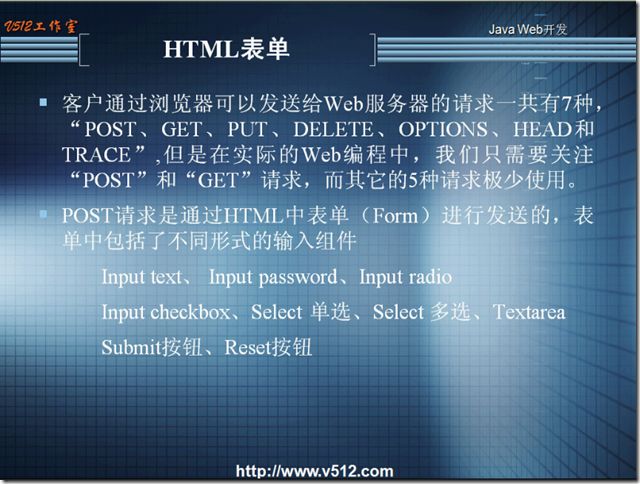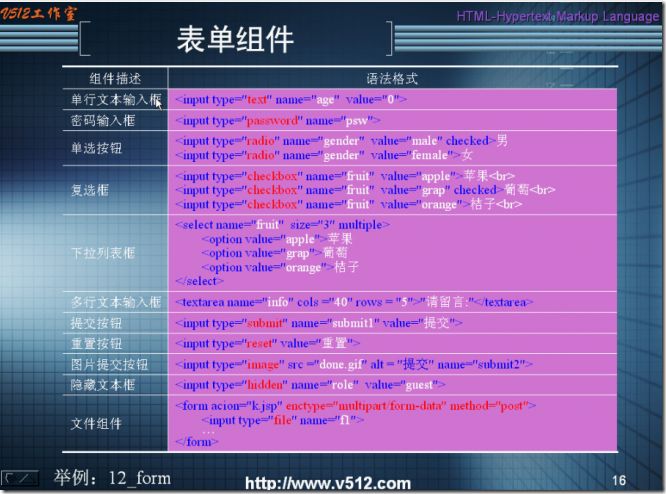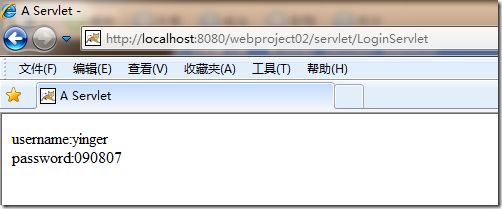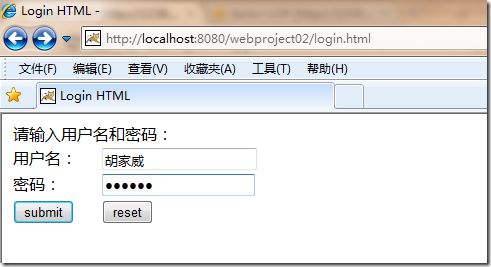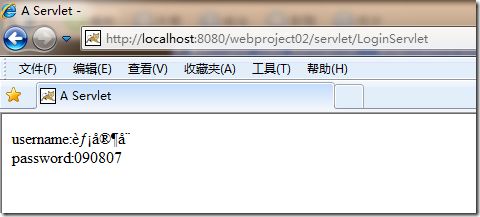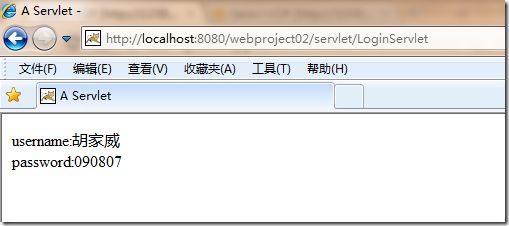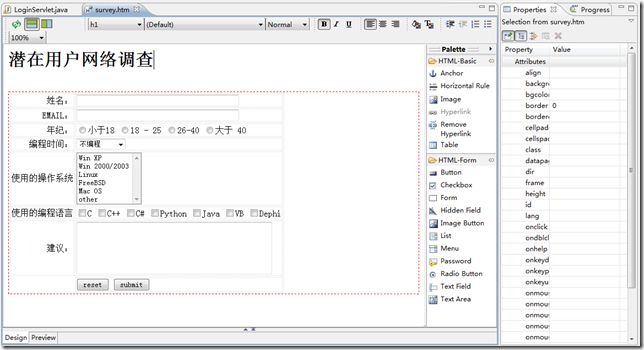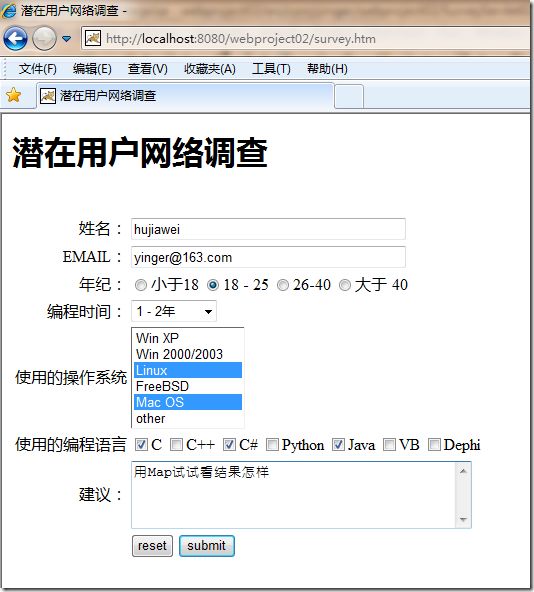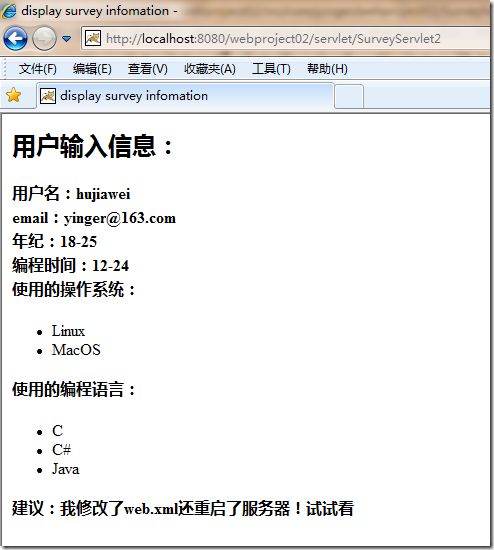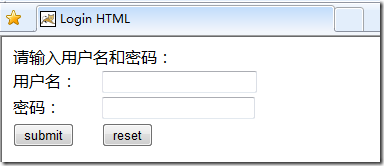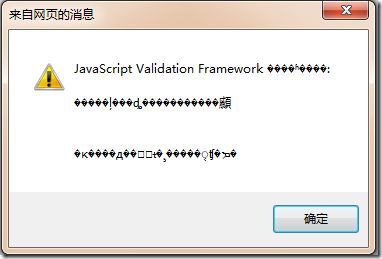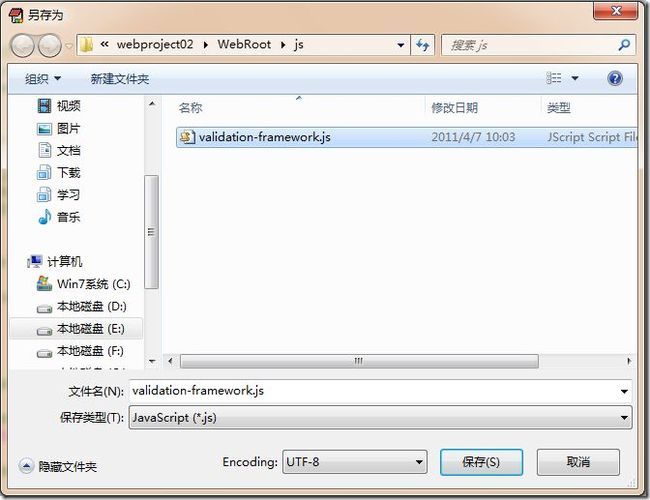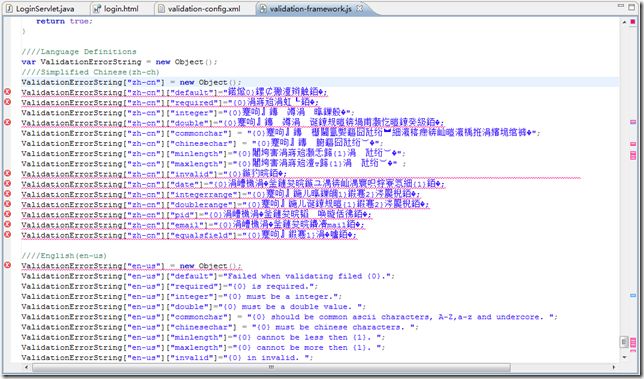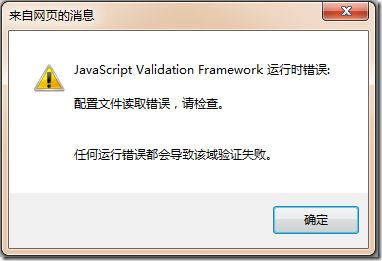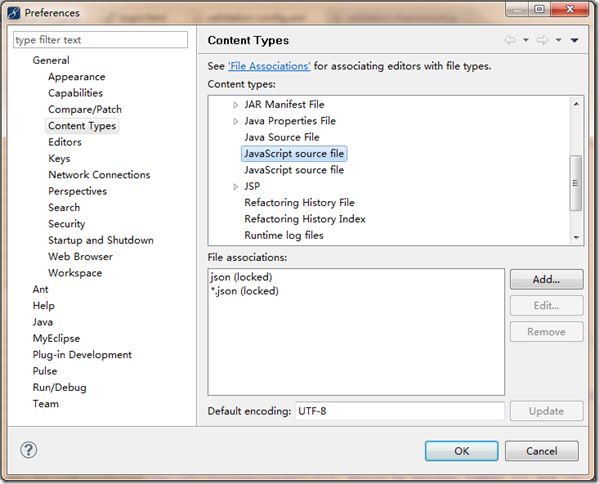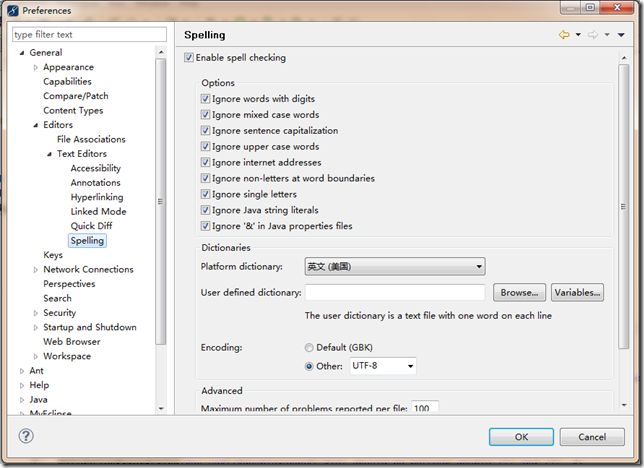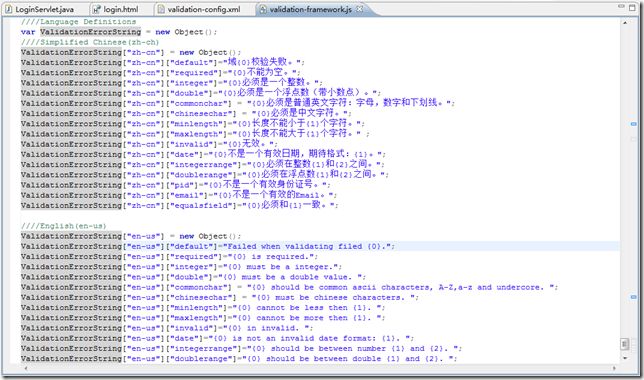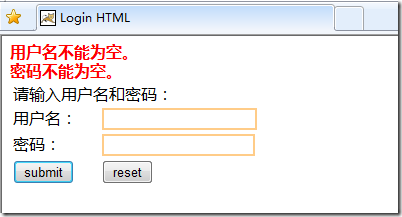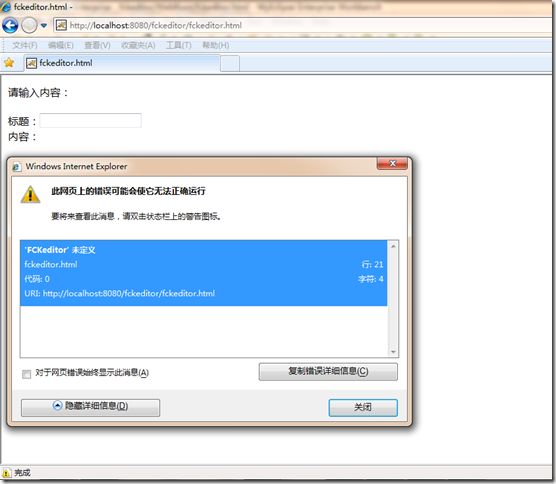JavaWeb学习 第4章 Servlet 表单处理
1.HTML 表单
name 相同的 radio 就是一组,只有一个能被选中
3. 试验
< html>
< head>
< meta http-equiv= "Content-Type" content= "text/html; charset=utf-8">
< title>Login HTML</ title>
</ head>
< body>
< form name= "loginform" action= "/webproject02/servlet/LoginServlet" method= "post" accept- charset= "utf-8">
< table width= "300" border= "0">
< tr>
< td colspan= "2">请输入用户名和密码:
</ td>
</ tr>
< tr>
< td>用户名:
</ td>
< td>< input type= "text" name= "username" size= "20" maxlength= "18">
</ td>
</ tr>
< tr>
< td>密码:
</ td>
< td>< input type= "password" name= "password" size= "21" maxlength= "18">
</ td>
</ tr>
< tr>
< td>< input type= "submit" name= "submit" value= "submit">
</ td>
< td>< input type= "reset" name= "reset" value= "reset">
</ td>
</ tr>
</ table>
</ form>
</ body>
</ html>
throws ServletException, IOException {
response.setContentType( "text/html");
PrintWriter out = response.getWriter();
out.println( "<!DOCTYPE HTML PUBLIC \"-//W3C//DTD HTML 4.01 Transitional//EN\">");
out.println( "<HTML>");
out.println( " <HEAD><TITLE>A Servlet</TITLE></HEAD>");
out.println( " <BODY>");
out.print( "username:" +request.getParameter( "username") + "<br>");
out.print( "password:" +request.getParameter( "password") + "<br>");
out.println( " </BODY>");
out.println( "</HTML>");
out.flush();
out.close();
}
< head>
< title>潜在用户网络调查</ title>
< meta http-equiv= "content-type" content= "text/html; charset=utf-8">
</ head>
< body>
< h1>潜在用户网络调查</ h1>
< br>
< form method= "post" action= "/webproject02/servlet/SurveyServlet">
< table border= "0">
< tr>
< td align= "right">姓名:</ td>
< td colspan= "2" align= "left">< input type= "text" name= "name" size= "40"></ td>
</ tr>
< tr>
< td align= "right">EMAIL:</ td>
< td colspan= "2" align= "left">< input type= "text" name= "email" size= "40"></ td>
</ tr>
< tr>
< td align= "right">年纪:</ td>
< td align= "left">
< input type= "radio" name= "age" value= "18">小于 18
< input type= "radio" name= "age" value= "18-25"> 18 - 25
< input type= "radio" name= "age" value= "26-40"> 26- 40
< input type= "radio" name= "age" value= ">40">大于 40
</ td>
</ tr>
< tr>
< td align= "right">编程时间:</ td>
< td align= "left">
< select name= "codetime" size= 1>
< option value= "never">不编程</ option>
< option value= "6"> 小于 6个月</ option>
< option value= "6-12"> 6 - 12 月</ option>
< option value= "12-24"> 1 - 2年</ option>
< option value= ">24"> 2年以上</ option>
</ select>
</ td>
</ tr>
< tr>
< td align= "right">使用的操作系统</ td>
< td align= "left">
< select name= "os" size= "6" multiple>
< option value= "WinXP">Win XP</ option>
< option value= "Win2000/2003">Win 2000/ 2003</ option>
< option value= "Linux">Linux</ option>
< option value= "FreeBSD">FreeBSD</ option>
< option value= "MacOS">Mac OS</ option>
< option value= "other">other</ option>
</ select>
</ td>
</ tr>
< tr>
< td>使用的编程语言</ td>
< td>< input type= "checkbox" name= "language" value= "C">C
< input type= "checkbox" name= "language" value= "C++">C++
< input type= "checkbox" name= "language" value= "C#">C#
< input type= "checkbox" name= "language" value= "Python">Python
< input type= "checkbox" name= "language" value= "Java">Java
< input type= "checkbox" name= "language" value= "VB">VB
< input type= "checkbox" name= "language" value= "Dephi">Dephi
</ td>
</ tr>
< tr>
< td align= "right">建议:</ td>
< td colspan= "2" align= "left">
< textarea name= "comment" cols= "40" rows= "4"></ textarea>
</ td>
</ tr>
< tr>
< td></ td>
< td>
< input type= "reset" value= "reset">
< input type= "submit" value= "submit">
</ td>
</ tr>
</ table>
</ form>
</ body>
</ html>
void dopublic Get(HttpServletRequest request, HttpServletResponse response)
throws ServletException, IOException {
response.setContentType( "text/html;charset=utf-8");
PrintWriter out = response.getWriter();
request.setCharacterEncoding( "utf-8");
out.println( "<html>");
out.println( "<head><title>display survey infomation</title></head>");
out.println( "<body>");
out.println( "<h2>用户输入信息:</h2>");
out.println( "<strong>用户名:" + filter(request.getParameter( "name"))
+ "</strong><br>");
out.println( "<strong>email:" + filter(request.getParameter( "email"))
+ "</strong><br>");
out.println( "<strong>年纪:" + request.getParameter( "age")
+ "</strong><br>");
out.println( "<strong>编程时间:" + request.getParameter( "codetime") // 得到某个组件得值
+ "</strong><br>");
out.println( "<strong>使用的操作系统:</strong>");
printValues(out, request.getParameterValues( "os")); // 得到某个表单组件的所有值,很多个值
out.println( "<strong>使用的编程语言:</strong>");
printValues(out, request.getParameterValues( "language"));
out.println( "<strong>建议:" + filter(request.getParameter( "comment"))
+ "</strong><br>");
out.println( "</body>");
out.println( "</html>");
out.flush();
out.close();
}
/**
* 输出字符串数组中所有的元素
*/
public void printValues(PrintWriter out, String[] values) {
if (values == null || values.length == 0) {
return;
}
out.println( "<ul>");
for ( int i = 0; i < values.length; i ++) {
out.println( "<li>" + values[i] + "</li>");
}
out.println( "</ul>");
}
/**
* 过滤<, >,\n 字符的方法
* @param input 需要过滤的字符
* @return 完成过滤以后的字符串
*/
public String filter(String input) {
if (input == null) {
return null;
}
if (input.length() == 0) {
return input;
}
input = input.replaceAll( "&", "&");
input = input.replaceAll( "<", "<");
input = input.replaceAll( ">", ">");
input = input.replaceAll( " ", " ");
input = input.replaceAll( "'", "'");
input = input.replaceAll( "\"", """);
return input.replaceAll( "\n", "<br>");
}
上篇讲到 Servlet 处理表单的一些知识,今天在这里继续这个话题,我们使用更多的其他的方法去获取和处理表单的数据,以方便以后在项目中遇到的各种问题,哈哈哈
SurveyServlet 的改进
很多时候,我们可能并不知道表单中的每一个组件的名字,所以,我们可以使用 request.getParameterNames 方法来获取
源码:
String parameterName = null;
while(e.hasMoreElements()){
parameterName = (String) e.nextElement();
String[] values = request.getParameterValues(parameterName);
out.println( "<ul><br>");
for( int i = 0;i <values.length;i ++){
out.println( "<li>" +values[i] + "</li><br>");
}
out.println( "</ul><br>");
}
因为大多数的内容和 SurveyServlet 差不多,所以我在Myeclipse 中直接 复制粘贴了一份 SurveyServlet.java 取名为 SurveyServlet2
然后把 survey.htm 中的 action也相应的改为 action="/webproject02/servlet/SurveyServlet2",然后测试吧!
(下)
1.JSValidation 验证框架
下载地址:http://download.csdn.net/source/904291 CSDN 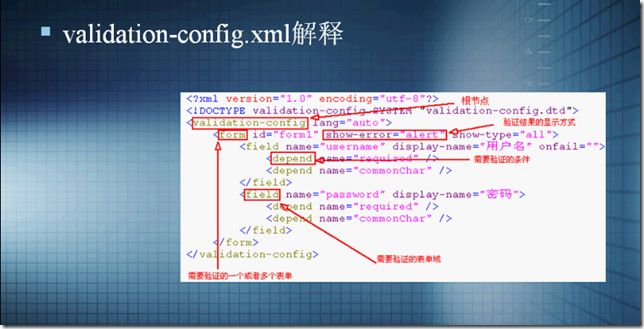
关于 JSValidation验证框架的介绍和用户手册请见我的另一篇日志:http://user.qzone.qq.com/1158112684/blog/1302069480
2.使用方法 以及 错误处理
将下载下来的两个文件 validation-framework.js 和 validation-config.xml 文件复制到 Web Project 的 WebRoot 目录下,然后修改
validation-config.js 文件
找到 var ValidationRoot = ""; 将其设置成该 js文件的路径 例如:var ValidationRoot = "/webproject02/js/";
然后配置 validation-config.xml 文件
配置方法详情请见我的那篇日志:http://user.qzone.qq.com/1158112684/blog/1302069480
这里我使用那篇日志中的 demo 为例,至于各个节点代表的含义自己看那篇日志吧,呵呵呵
<!--校验登陆,简单。复杂的例子请看Demo-->
<validation-config>
<form id="loginform" show-error="alert" onfail="">
<field name="username" display-name="用户名" onfail="">
<depend name="required" />
<depend name="commonChar" />
</field>
<field name="password" display-name="密码" onfail="">
<depend name="required" />
</field>
</form>
</validation-config>
迫不及待了,试试看!
打开 登陆页面
不填入任何信息,点击 submit。 啊! 又错了!!!! 一堆乱码,不知道错在哪里!
视频解释说要将 js 文件设置为 UTF-8 的编码格式才行,呵呵呵,有道理!用 EditPlus 打开,然后另存为,注意选择编码方式为 UTF-8
根据这位前辈的提示,我按要求重新设置了一下 Myeclipse ,哈哈哈
Spelling
果然,乱码消失了!!!!
另外,输入文本框也是高亮显示,呵呵呵,太方便了,呵呵呵! 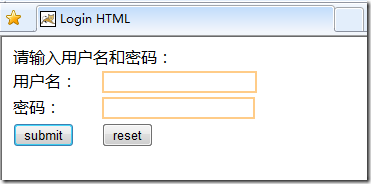
3. 改变错误提示方式:改为 显示在页面中,加上一个 div
在html 中
<div id="error" style="color:red;font-weight:bold;"></div>
<form id="loginform" name="loginform" action="/webproject02/servlet/LoginServlet" method="post" accept-charset="utf-8" onsubmit="return doValidate(this)" >
在xml 中
< form id= "loginform" show-error= "error" onfail= ""> // form 的 id 对应于 HTML 页面中的 form 的 id,show-error 表示 错误的显示方式
<field name= "username" display- name= "用户名" onfail= "">
<depend name= "required" />
<depend name= "commonChar" />
</field>
<field name= "password" display- name= "密码" onfail= "">
<depend name= "required" />
</field>
</ form>
</validation-config>
显示效果: 呵呵呵,还不错嘛
4.FCKeditor:用 Javascript 写的 网页上的编辑器
下载地址:http://ckeditor.com/download
它实际上是用 JavaScript 写的,只要浏览器支持就可以了,和编程语言无关
使用方法:(我的测试方案)
① 将 下载下来的 Zip 文件解压到 Web Project 中,放置在一个文件夹中,例如:fckeditor,然后刷新该 Project
② 新建一个 HTML 文件,fckeditor.html ,添加 js 文件的引用,然后建立一个表单,并在表单中添加那个 FCKeditor
HTML源码:
< head>
< title>fckeditor. html</ title>
< script type= "text/javascript" src= "/fckeditor/fckeditor/fckeditor.js"></ script> // 引用它
< meta http-equiv= "content-type" content= "text/html; charset=UTF-8">
</ head>
< body>
请输入内容:< br>
< form name= "content" id= "form" action= "/fckeditor/servlet/addContent" method= "post"> // method 是 post ,因为处理内容比较多
标题:< input type= "text" name= "title" size= "80"/>< br> // name 属性是用于后面获取它的内容
内容:< br>
< script type= "text/javascript">
var editor = new FCKeditor('editor1'); // 这个 editor1 很重要,后面要获取其中的内容就是用它!
editor.BasePath = '/fckeditor/fckeditor/'; // 这个也很重要,设置那个 js 文件在这个项目的位置
editor. Height = 200; // 设置长和宽
editor. Width = 800;
editor.ToolbarSet = 'Default'; // 设置工具栏的样式,这里是默认的情况
editor.Create(); // 创建 editor
</ script>
< input name= "submit" type= "submit" value= "submit">
</ form>
</ body>
</ html>
③新建一个处理表单的 Servlet 程序:
源码:只列出它的一个方法 doPost
throws ServletException, IOException {
response.setContentType( "text/html;charset=utf-8");
request.setCharacterEncoding( "utf-8");
PrintWriter out = response.getWriter();
out.println( "<!DOCTYPE HTML PUBLIC \"-//W3C//DTD HTML 4.01 Transitional//EN\">");
out.println( "<HTML>");
out.println( " <HEAD><TITLE>A Servlet</TITLE></HEAD>");
out.println( " <BODY>");
out.println( "标题是:" +request.getParameter( "title") + "<br>");
out.println( "内容是:" +request.getParameter( "editor1") + "<br>");
out.println( " </BODY>");
out.println( "</HTML>");
out.flush();
out.close();
}
ok! 一切准备就绪,启动Tomcat,发布网站,呵呵呵呵,测试一下
处理结果:
但是过程中,我还是出现了一些错误的,呵呵呵,例如:
也就是 FCKeditor 没有显示出来,原因一般都是 书写时出现了一些 字母输入错误,呵呵呵 ,记住 是 FCKeditor!!!!
【还有一个问题:那就是在 Chrome 浏览器中显示不出来!可能是不兼容的原因吧,应该没有其他的问题,所以这个最好是开发针对 IE 浏览器的项目使用,其他的最好抛弃它】
5. Myeclipse 中的一个使用技巧
我们经常会发现我们有些文件或者文件夹并没有什么问题,但是 Myeclipse 总是在 图标的 左边 打上一个黄色的感叹号!很是烦人啊
解决办法:点击右键,选择 Myeclipse ,然后选择 “ Exclude from Validation” ,可以了 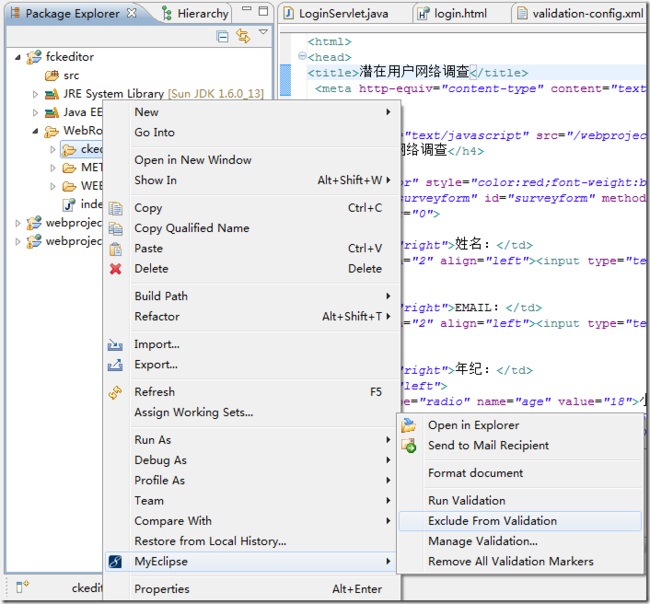
效果:
